Snow Cover Monitoring with Chinese Gaofen-4 PMS Imagery and the Restored Snow Index (RSI) Method: Case Studies
Abstract
1. Introduction
2. Data Source
2.1. GF-4 PMS Images
2.2. Landsat-8 OLI Images
3. Methodology
3.1. Spectral Matching between PMS and OLI
3.2. Restoration of Reflectance of Snow Cover in the SWIR Band
3.2.1. Clustering and Regression
3.2.2. Classification and Restoration
3.3. Restored Snow Index
4. Validation
4.1. Test Sites
4.2. Results
4.3. Comparison between RSI and NDSI
5. Discussion
5.1. Signal Saturation
5.2. Cloud Contamination
5.3. Limitations and Perspectives
6. Conclusions
Author Contributions
Funding
Acknowledgments
Conflicts of Interest
References
- Riggs, G.A.; Hall, D.K.; Román, M.O. Overview of NASA’s MODIS and Visible Infrared Imaging Radiometer Suite (VIIRS) snow-cover Earth System Data Records. Earth Syst. Sci. Data 2017, 9, 765–777. [Google Scholar] [CrossRef]
- Frei, A.; Tedesco, M.; Lee, S.; Foster, J.; Hall, D.K.; Kelly, R.; Robinson, D.A. A review of global satellite-derived snow products. Adv. Space Res. 2012, 50, 1007–1029. [Google Scholar] [CrossRef]
- Shreve, C.M.; Okin, G.S.; Painter, T.H. Indices for estimating fractional snow cover in the western Tibetan Plateau. J. Glaciol. 2009, 55, 737–745. [Google Scholar] [CrossRef]
- Dobreva, I.D.; Klein, A.G. Fractional snow cover mapping through artificial neural network analysis of MODIS surface reflectance. Remote Sens. Environ. 2011, 115, 3355–3366. [Google Scholar] [CrossRef]
- Dozier, J. Spectral signature of alpine snow cover from the Landsat Thematic Mapper. Remote Sens. Environ. 1989, 45, 9–22. [Google Scholar] [CrossRef]
- Bojinski, S.; Verstraete, M.; Peterson, T.C.; Richter, C.; Simmons, A.; Zemp, M. The Concept of Essential Climate Variables in Support of Climate Research, Applications, and Policy. B. Am. Meteorol. Soc. 2014, 95, 1431–1443. [Google Scholar] [CrossRef]
- Facts about Glaciers | National Snow and Ice Data Center. Available online: https://nsidc.org/cryosphere/glaciers/quickfacts.html (accessed on 7 October 2018).
- Ice and Glaciers -The Water Cycle-USGS Water-Science School. Available online: https://water.usgs.gov/edu/watercycleice.html (accessed on 7 October 2018).
- Dozier, J. Opportunities to improve hydrologic data. Rev. Geophys. 1992, 30, 315–331. [Google Scholar] [CrossRef]
- Douville, H.; Chauvin, F.; Planton, S.; Royer, J.F.; Salas-Mélia, D.; Tyteca, S. Sensitivity of the hydrological cycle to increasing amounts of greenhouse gases and aerosols. Clim. Dynam. 2002, 20, 45–68. [Google Scholar]
- Barnett, T.P.; Adam, J.C.; Lettenmaier, D.P. Potential impacts of a warming climate on water availability in snow-dominated regions. Nature 2005, 438, 303. [Google Scholar] [CrossRef] [PubMed]
- Bales, R.C.; Molotch, N.P.; Painter, T.H.; Dettinger, M.D.; Rice, R.; Dozier, J. Mountain hydrology of the western United States. Water Resour. Res. 2006, 42, W8432. [Google Scholar] [CrossRef]
- Painter, T.H.; Rittger, K.; Mckenzie, C.; Slaughter, P.; Davis, R.E.; Dozier, J. Retrieval of subpixel snow covered area, grain size, and albedo from MODIS. Remote Sens. Environ. 2009, 113, 868–879. [Google Scholar] [CrossRef]
- Rango, A. Spaceborne remote sensing for snow hydrology applications. Hydrolog. Sci. J. 1996, 41, 477–494. [Google Scholar] [CrossRef]
- Dobreva, I.D.; Klein, A.G. Fractional snow cover mapping through artificial neural network analysis of MODIS surface reflectance. Remote Sens. Environ. 2011, 115, 3355–3366. [Google Scholar] [CrossRef]
- Derksen, C.; Ledrew, E. Variability and change in terrestrial snow cover: Data acquisition and links to the atmosphere. Prog. Phys. Geog. 2000, 24, 469–498. [Google Scholar] [CrossRef]
- Nolin, A.W.; Liang, S. Progress in bidirectional reflectance modeling and applications for surface particulate media: Snow and soils. Remote Sens. Reviews 2000, 18, 307–342. [Google Scholar] [CrossRef]
- Singh, S.K.; Kulkarni, A.V.; Chaudhary, B.S. Hyperspectral analysis of snow reflectance to understand the effects of contamination and grain size. Ann. Glaciol. 2010, 51, 83–88. [Google Scholar] [CrossRef]
- Hall, D.K.; Riggs, G.A.; Salomonson, V.V. Development of Methods for Mapping Global Snow Cover Using Moderate Resolution Imaging Spectroradiometer Data. Remote Sens. Environ. 1995, 54, 127–140. [Google Scholar] [CrossRef]
- Hall, D.K.; Foster, J.L.; Verbyla, D.L.; Klein, A.G.; Benson, C.S. Assessment of Snow-Cover Mapping Accuracy in a Variety of Vegetation-Cover Densities in Central Alaska. Remote Sens. Environ. 1998, 66, 129–137. [Google Scholar] [CrossRef]
- Hall, D.K.; Riggs, G.A.; Salomonson, V.V.; Digirolamo, N.E.; Bayr, K.J. MODIS snow-cover products. Remote Sens. Environ. 2002, 83, 181–194. [Google Scholar] [CrossRef]
- Salomonson, V.V.; Appel, I. Estimating fractional snow cover from MODIS using the normalized difference snow index. Remote Sens. Environ. 2004, 89, 351–360. [Google Scholar] [CrossRef]
- Salomonson, V.; Appel, I. Development of the Aqua MODIS NDSI fractional snow cover algorithm and validation results. IEEE T. Geosci. Remote 2006, 44, 1747–1756. [Google Scholar] [CrossRef]
- Shimamura, Y.; Izumi, T.; Matsuyama, H. Evaluation of a useful method to identify snow-covered areas under vegetation-comparisons among a newly proposed snow index, normalized difference snow index, and visible reflectance. Int. J. Remote Sens. 2006, 27, 4867–4884. [Google Scholar] [CrossRef]
- Steele, C.; Dialesandro, J.; James, D.; Elias, E.; Rango, A.; Bleiweiss, M. Evaluating MODIS snow products for modelling snowmelt runoff: Case study of the Rio Grande headwaters. Int. J. Appl. Earth Obs. 2017, 63, 234–243. [Google Scholar] [CrossRef]
- Wang, S.; Yin, H.; Yang, Q.; Yin, H.; Wang, X.; Peng, Y.; Shen, M. Spatiotemporal patterns of snow cover retrieved from NOAA-AVHRR LTDR: a case study in the Tibetan Plateau, China. Int. J. Digit. Earth 2017, 10, 1–18. [Google Scholar] [CrossRef]
- Wang, M.; Cheng, Y.; Chang, X.; Jin, S.; Zhu, Y. On-orbit geometric calibration and geometric quality assessment for the high-resolution geostationary optical satellite GaoFen4. Isprs J. Photogramm. 2017, 125, 63–77. [Google Scholar] [CrossRef]
- Xu, J.; Liang, Y.; Liu, J.; Huang, Z. Multi-Frame Super-Resolution of Gaofen-4 Remote Sensing Images. Sensors 2017, 17. [Google Scholar] [CrossRef]
- Yang, A.; Zhong, B.; Wu, S.; Liu, Q. Radiometric Cross-Calibration of GF-4 in Multispectral Bands. Remote Sens. 2017, 9, 232. [Google Scholar] [CrossRef]
- Chen, Y.; Sun, K.; Li, D.; Bai, T.; Huang, C. Radiometric Cross-Calibration of GF-4 PMS Sensor Based on Assimilation of Landsat-8 OLI Images. Remote Sens. 2017, 9, 811. [Google Scholar] [CrossRef]
- Dowman, I.; Dolloff, J.T. An evaluation of rational function for photogrammetric restitution. Int. Arch. Photogramm. Remote Sens. 2000, 33, 254–266. [Google Scholar]
- Satir, O. Comparing the satellite image transformation techniques for detecting and monitoring the continuous snow cover and glacier in Cilo mountain chain Turkey. Ecol. Indic. 2016, 69, 261–268. [Google Scholar] [CrossRef]
- Dedieu, J.; Carlson, B.Z.; Bigot, S.; Sirguey, P.; Vionnet, V.; Choler, P. On the Importance of High-Resolution Time Series of Optical Imagery for Quantifying the Effects of Snow Cover Duration on Alpine Plant Habitat. Remote Sens. Basel 2016, 8, 481. [Google Scholar] [CrossRef]
- How does the Pixel Aggregate Method Work When Resizing Data with ENVI? Available online: https://www.harrisgeospatial.com/Support/Self-Help-Tools/Help-Articles/Help-Articles-Detail/ArtMID/10220/ArticleID/16094/How-does-the-Pixel-Aggregate-method-work-when-resizing-data-with-ENVI- (accessed on 11 October 2018).
- Zhang, T.; Ren, H.; Qin, Q.; Zhang, C.; Sun, Y. Surface Water Extraction From Landsat 8 OLI Imagery Using the LBV Transformation. IEEE J. Sel. Top. Appl. 2017, 10, 4417–4429. [Google Scholar] [CrossRef]
- Barsi, J.; Lee, K.; Kvaran, G.; Markham, B.; Pedelty, J. The Spectral Response of the Landsat-8 Operational Land Imager. Remote Sens. Basel 2014, 6, 10232–10251. [Google Scholar] [CrossRef]
- Baldridge, A.M.; Hook, S.J.; Grove, C.I.; Rivera, G. The ASTER spectral library version 2.0. Remote Sens. Environ. 2009, 113, 711–715. [Google Scholar] [CrossRef]
- Gladkova, I.; Grossberg, M.D.; Shahriar, F.; Bonev, G.; Romanov, P. Quantitative Restoration for MODIS Band 6 on Aqua. IEEE T. Geosci. Remote 2012, 50, 2409–2416. [Google Scholar] [CrossRef]
- Gladkova, I.; Grossberg, M.; Bonev, G.; Romanov, P.; Shahriar, F. Increasing the Accuracy of MODIS/Aqua Snow Product Using Quantitative Image Restoration Technique. IEEE Geosci. Remote Sens. 2012, 9, 740–743. [Google Scholar] [CrossRef]
- Hartigan, J.A.; Wong, M.A. Algorithm AS 136: A k-means clustering algorithm. J. Royal Stat. Soc. Ser. C (Appl. Stat.) 1979, 28, 100–108. [Google Scholar] [CrossRef]
- MacKay, D.J. A practical Bayesian framework for backpropagation networks. Neural comput. 1992, 4, 448–472. [Google Scholar] [CrossRef]
- Fisher, A.; Flood, N.; Danaher, T. Comparing Landsat water index methods for automated water classification in eastern Australia. Remote Sens. Environ. 2016, 175, 167–182. [Google Scholar] [CrossRef]
- Fisher, A.; Danaher, T. A Water Index for SPOT5 HRG Satellite Imagery, New South Wales, Australia, Determined by Linear Discriminant Analysis. Remote Sens. Basel 2013, 5, 5907–5925. [Google Scholar] [CrossRef]
- Kak, A.C.; Martínez, A.M. PCA versus LDA. IEEE T. Pattern Anal. 2001, 23, 228–233. [Google Scholar]
- Hu, C.; Bai, Y.; Tang, P. Automatic cloud detection for GF-4 series images. J. Remote Sens. 2018, 22, 132–142. [Google Scholar]
- Zheng, L.; Wu, Y.; Yu, T.; Yang, J.; Zhang, Z. Object-based cloud detection of multitemporal high-resolution stationary satellite images. Opt. Eng. 2017, 56, 73103. [Google Scholar] [CrossRef]
- Allen, R.C.; Durkee, P.A.; Wash, C.H. Snow/Cloud Discrimination with Multispectral Satellite Measurements. J. Appl. Meteorol. 1990, 29, 994–1004. [Google Scholar] [CrossRef]
- Zhang, Y.; Kan, X.; Ren, W.; Cao, T.; Tian, W.; Wang, J. Snow Cover Monitoring in Qinghai-Tibetan Plateau Based on Chinese Fengyun-3/VIRR Data. J. Indian. Soc. Remote Sens. 2016, 45, 271–283. [Google Scholar] [CrossRef]
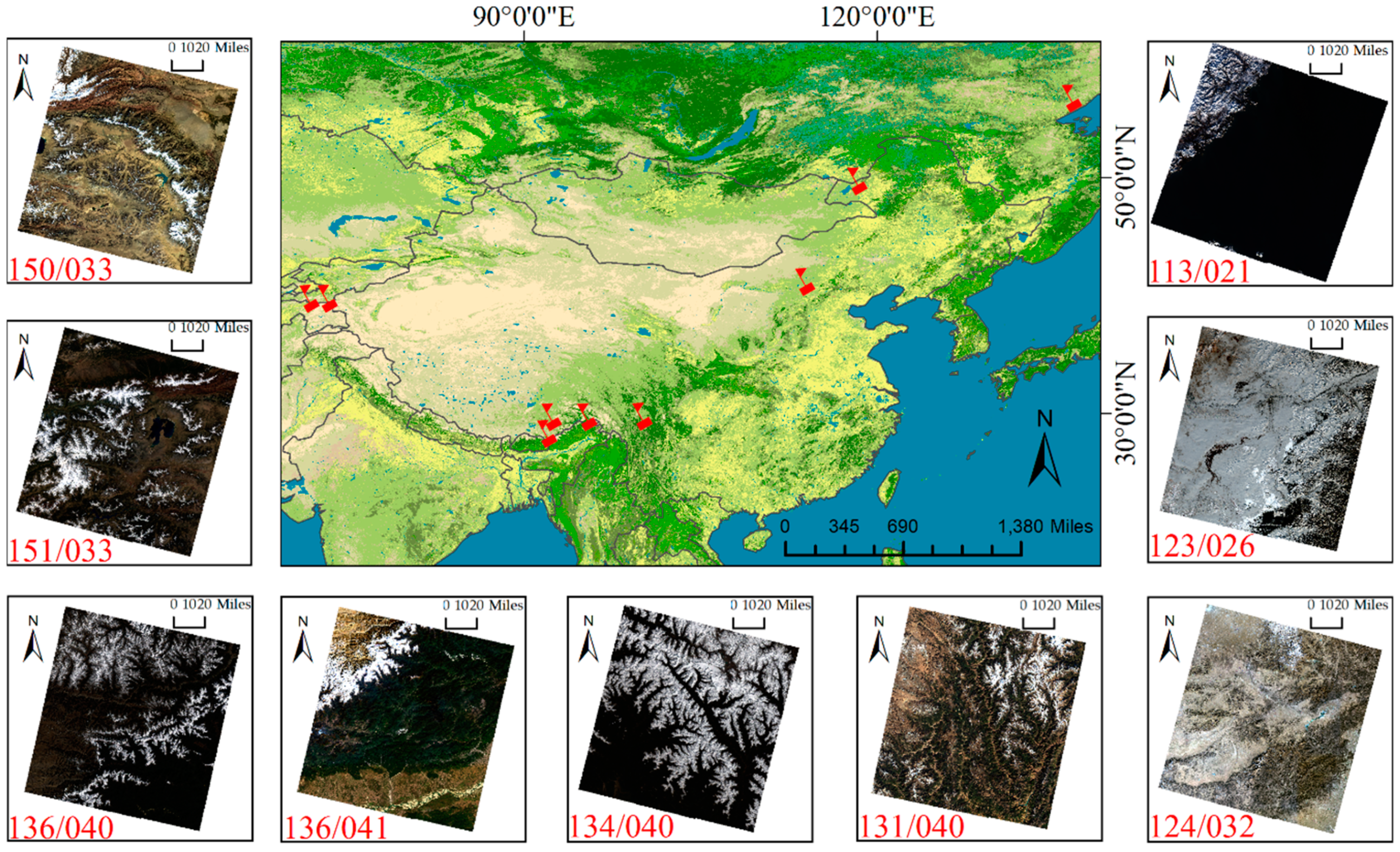

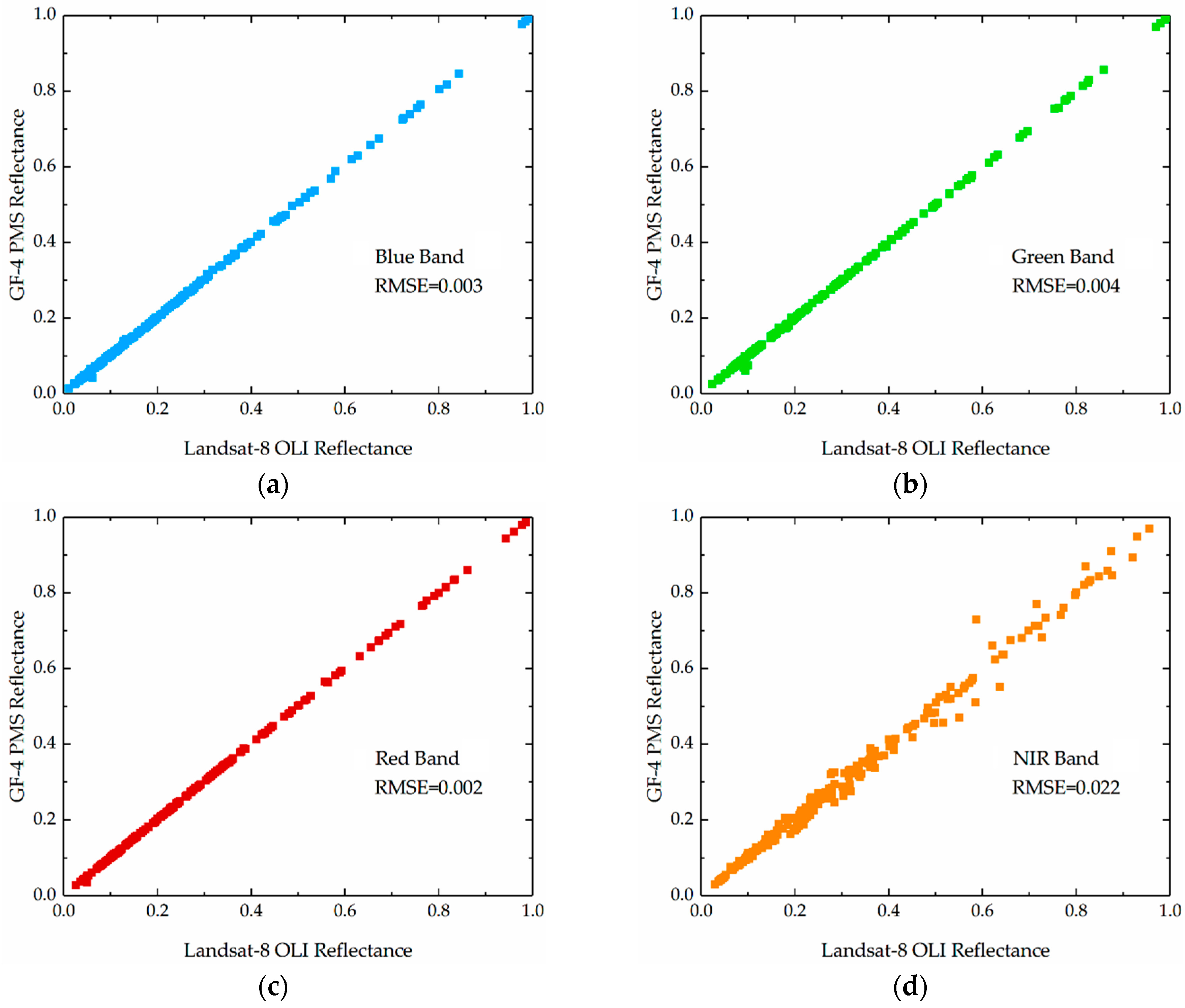
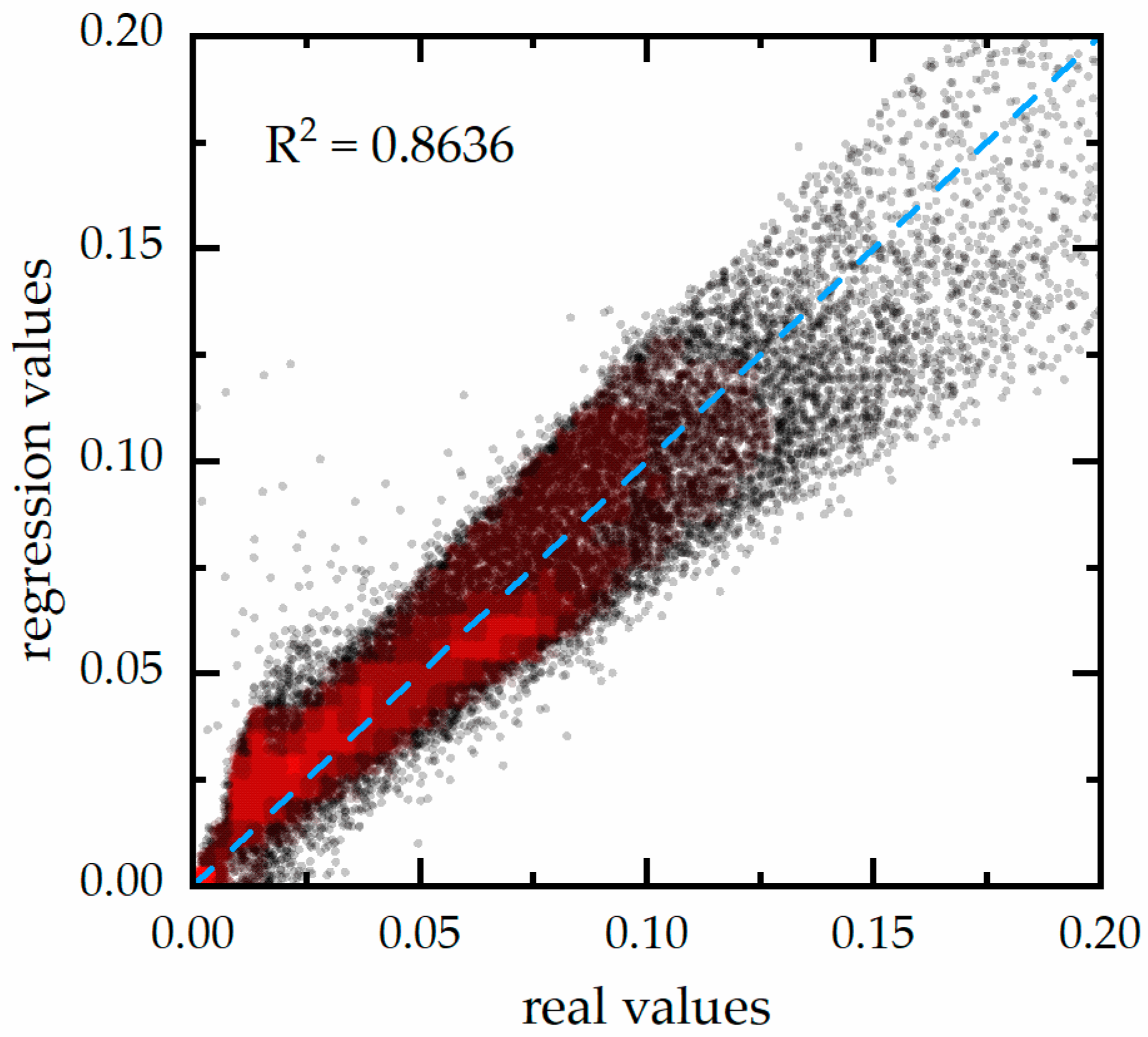
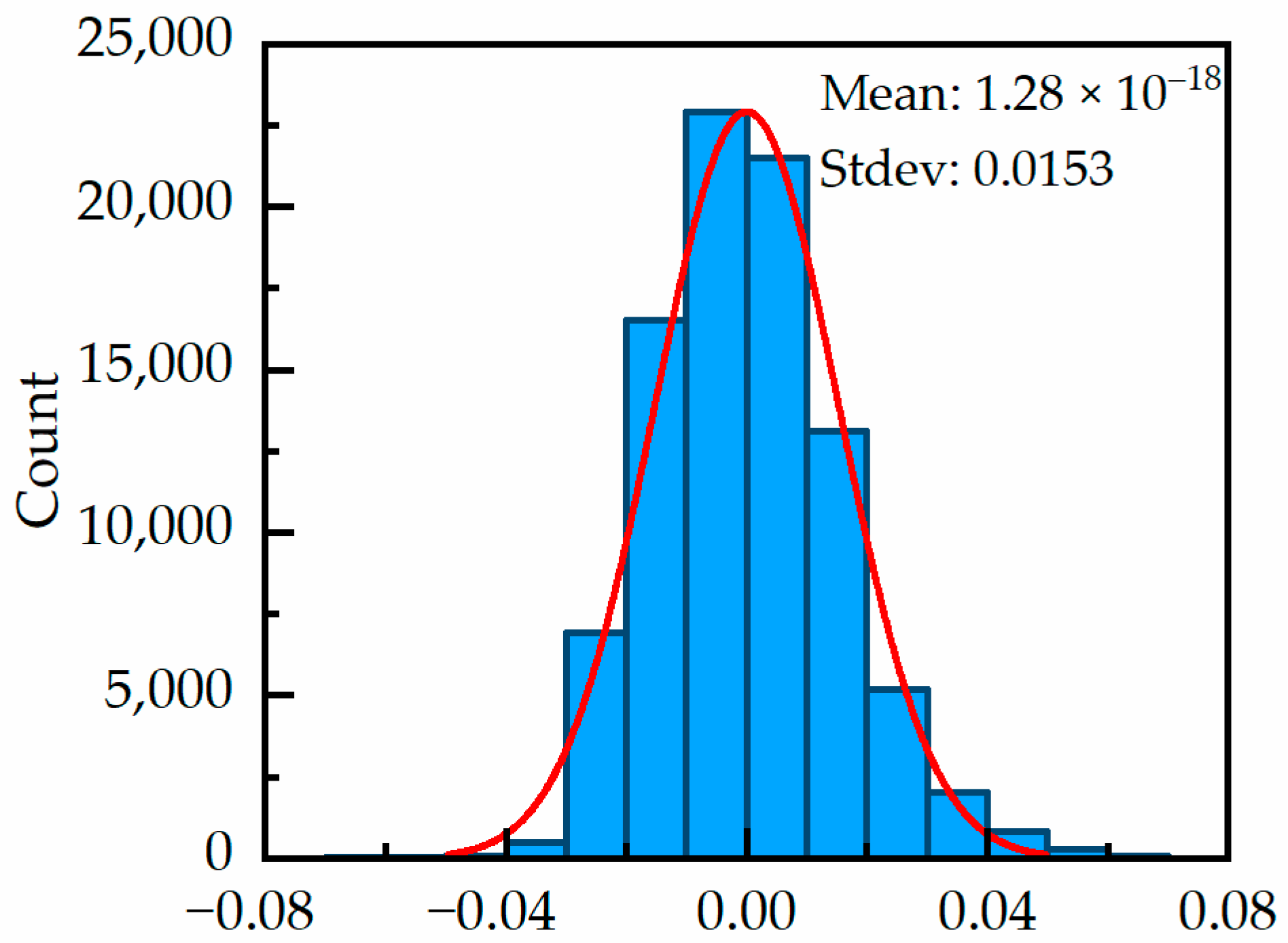


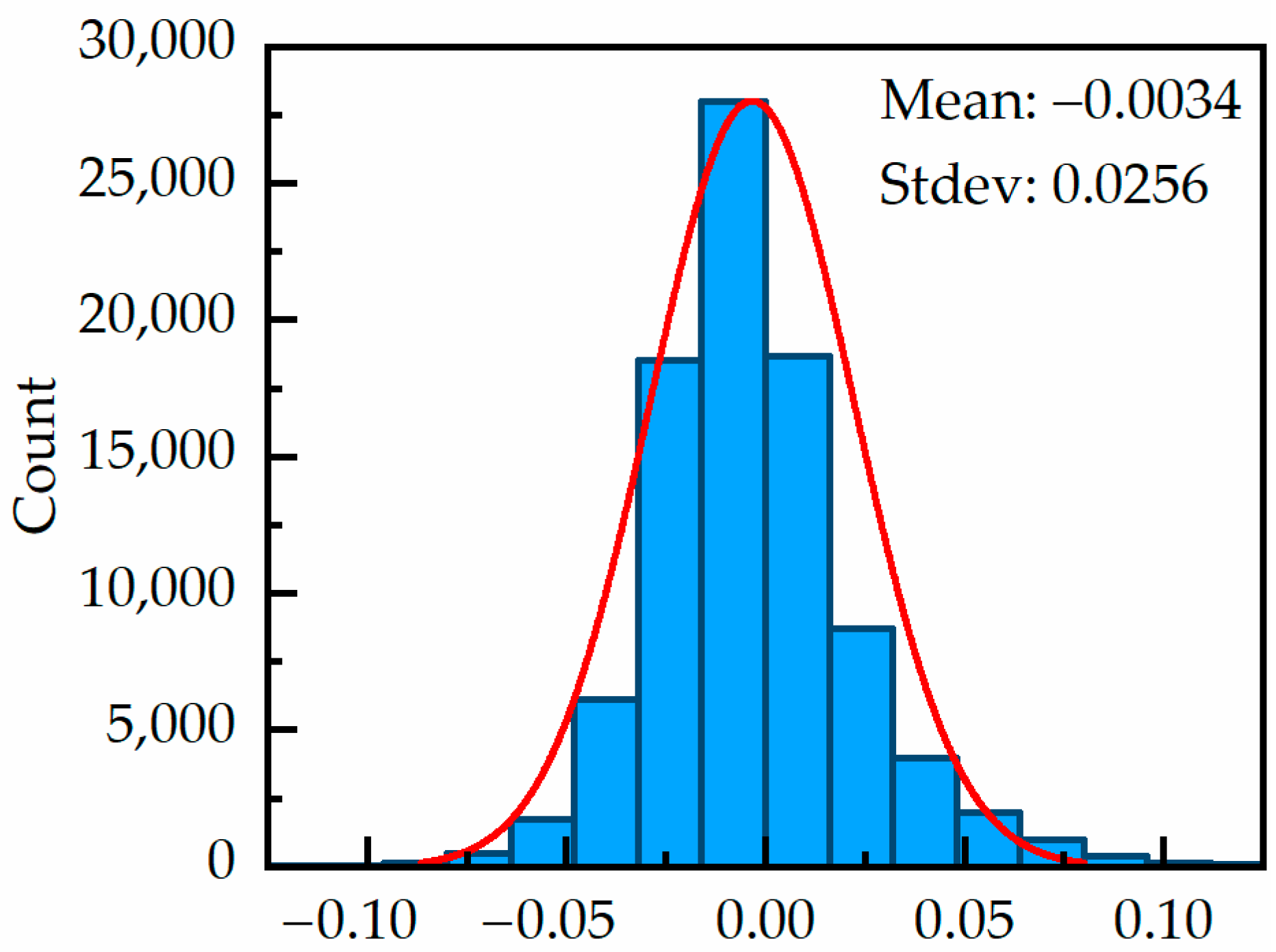
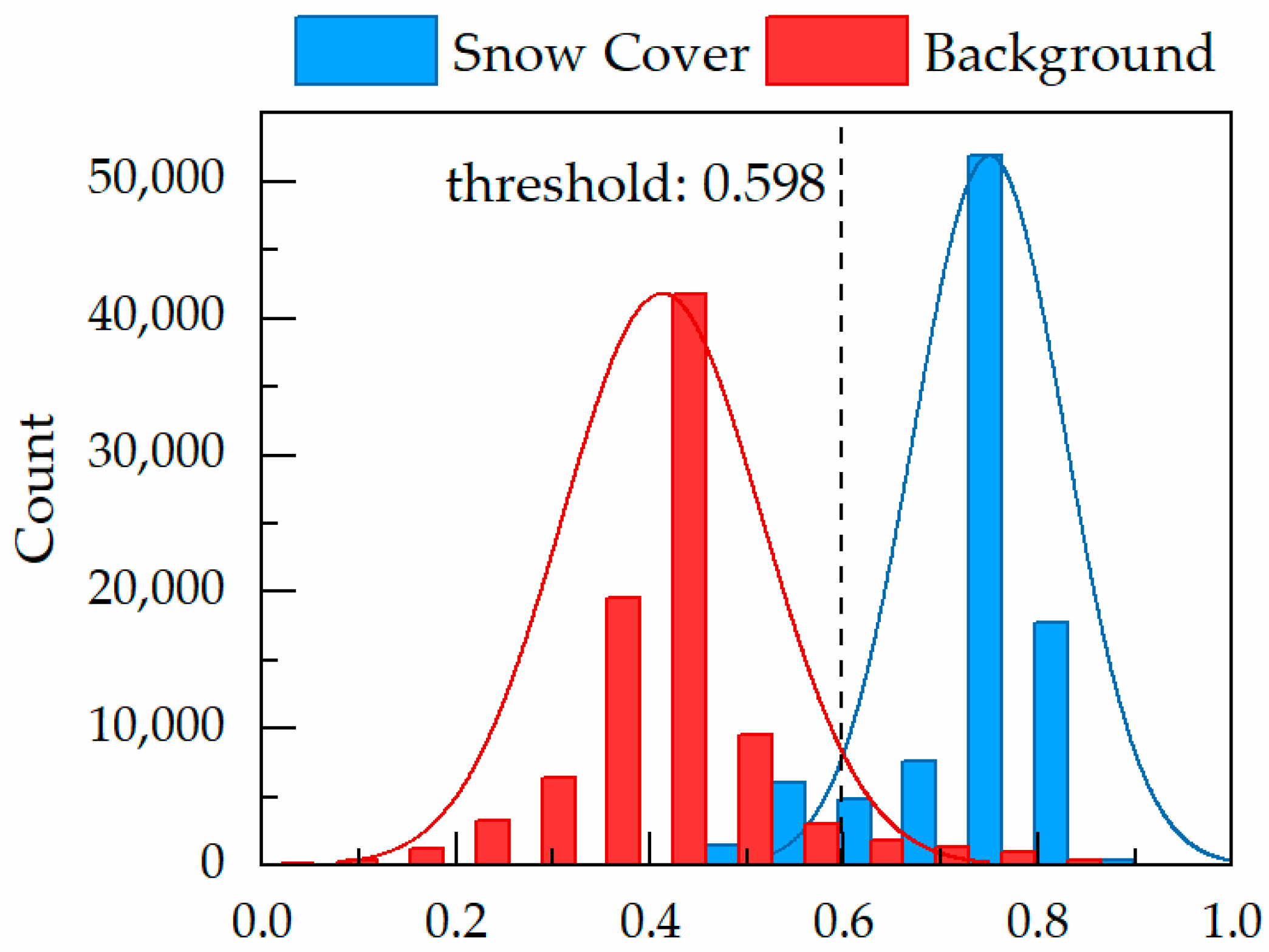
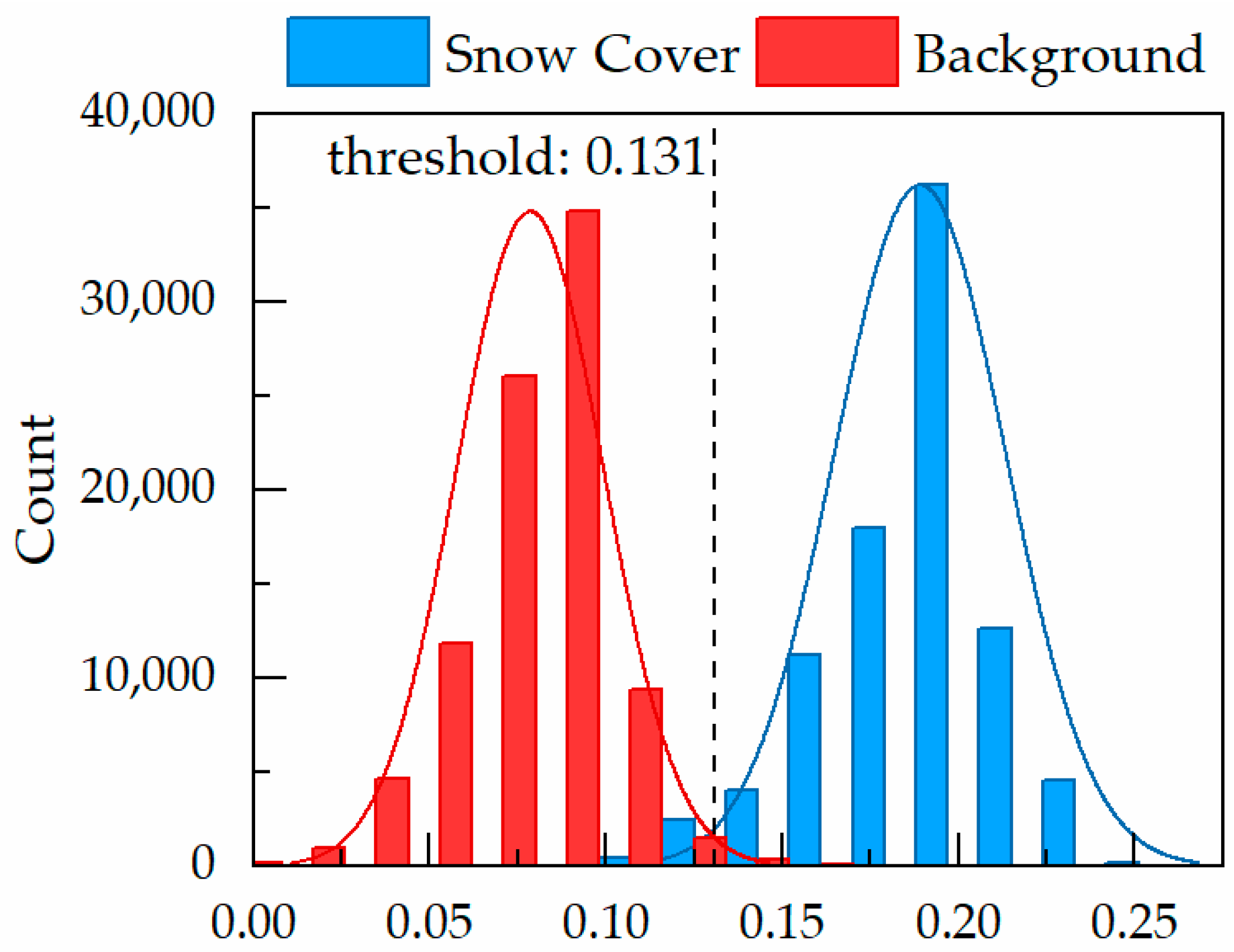

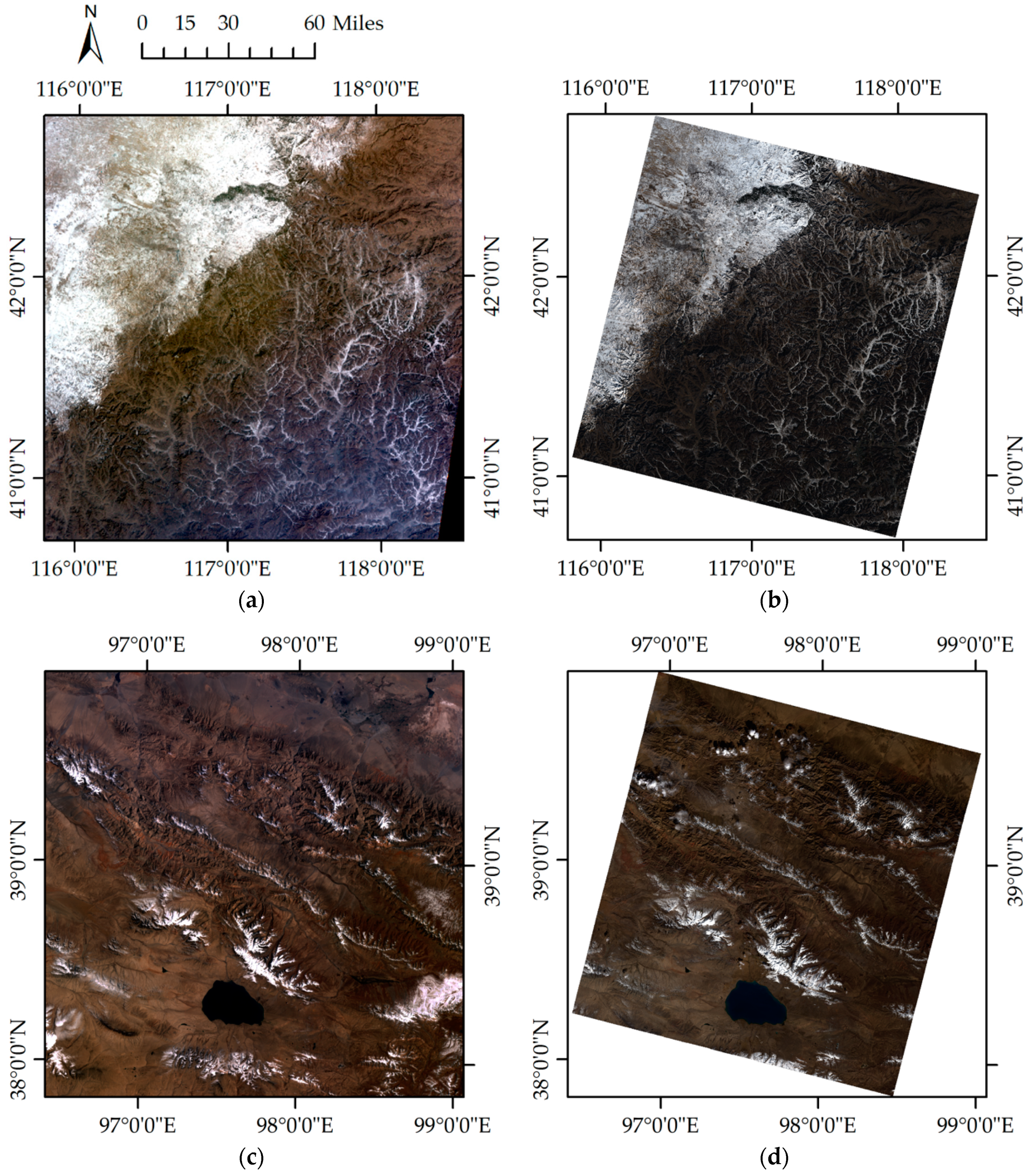
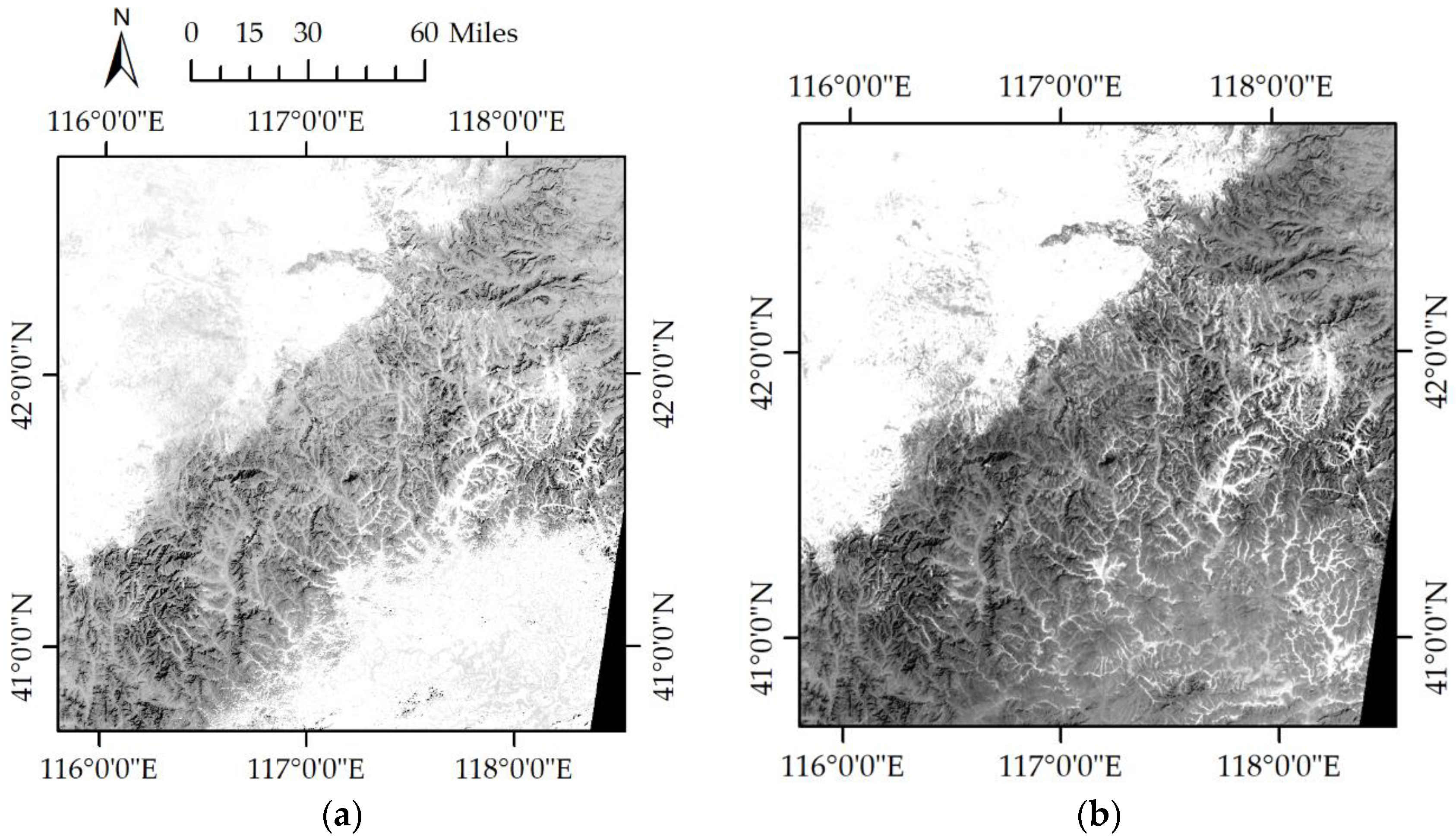
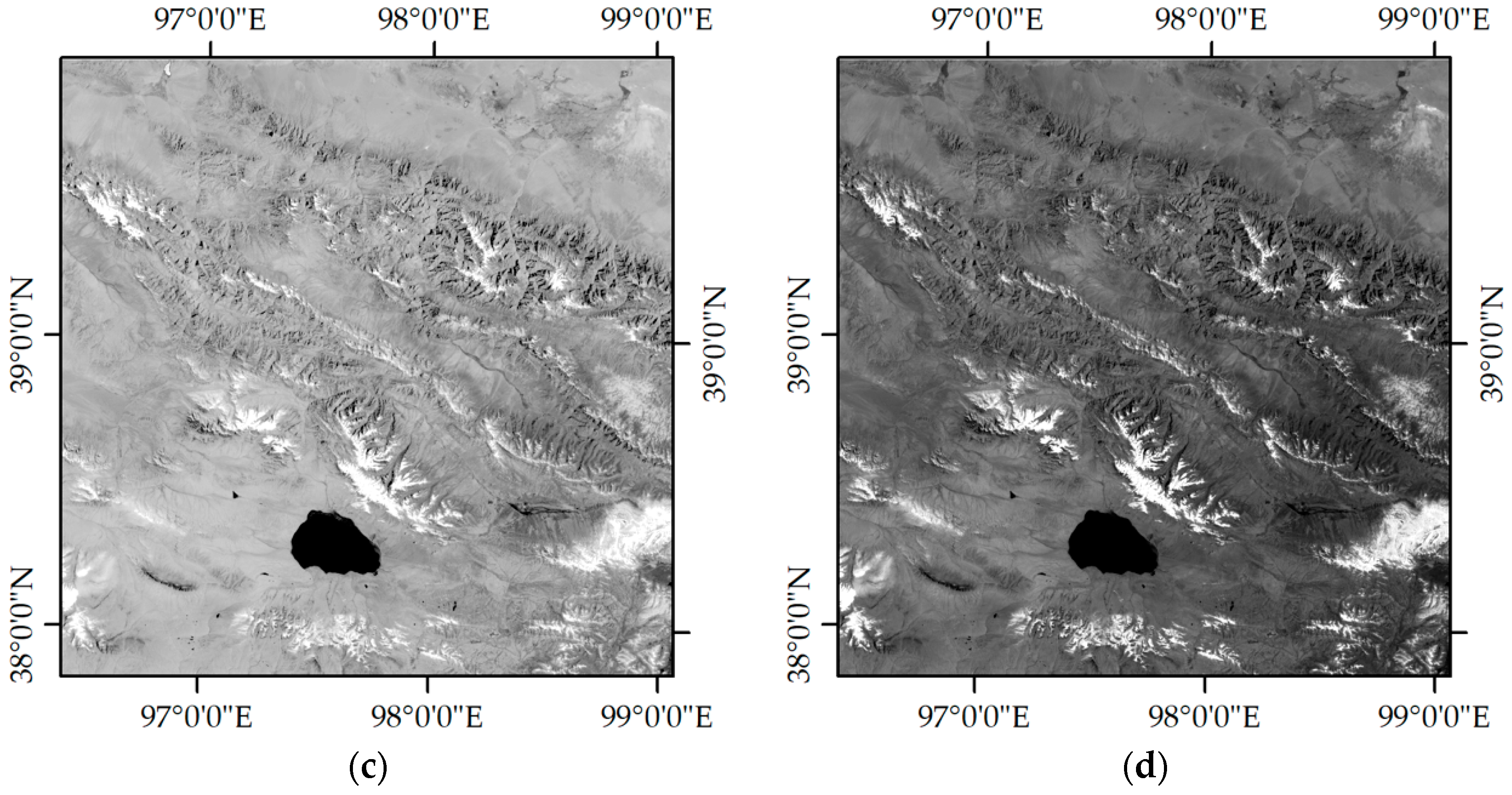
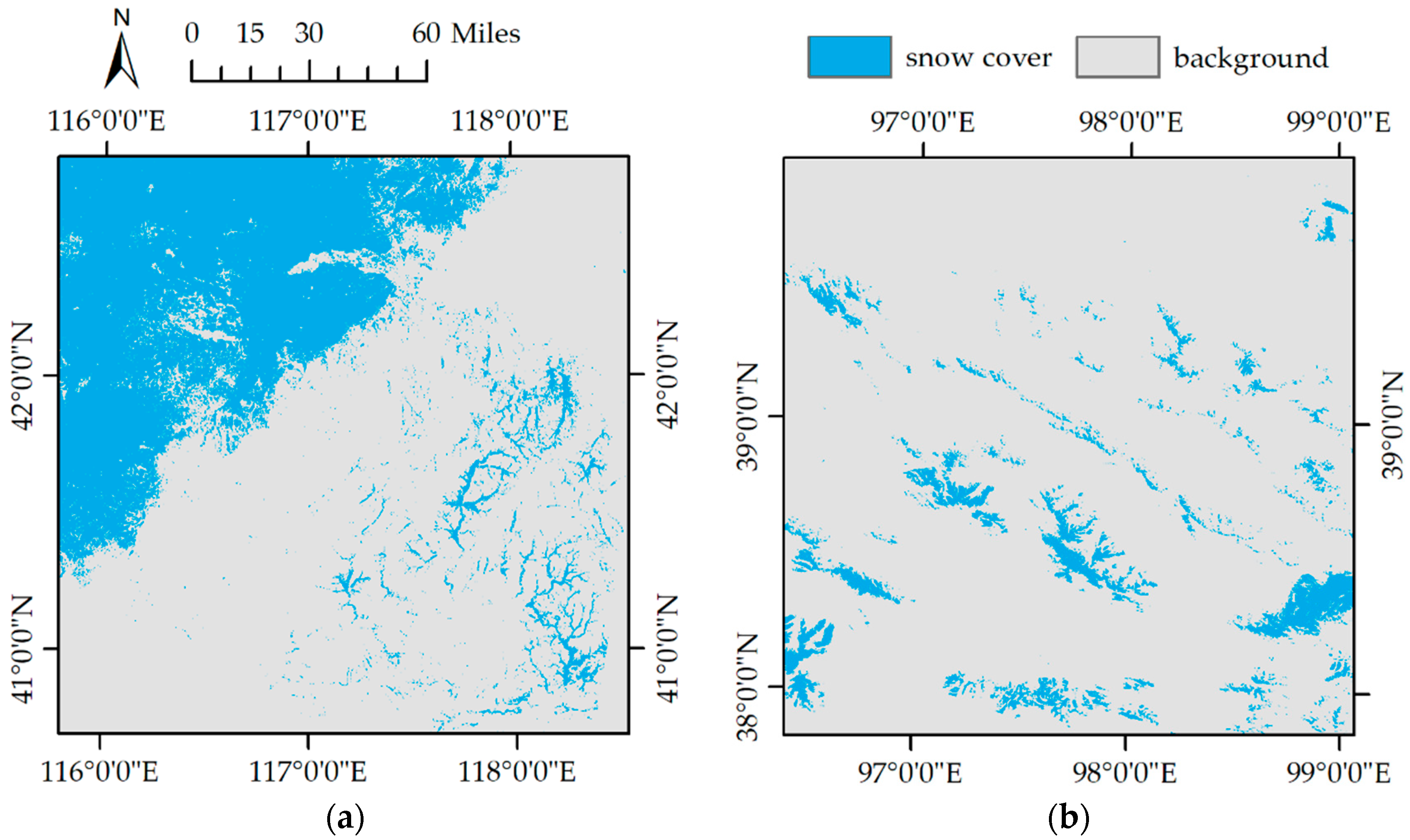

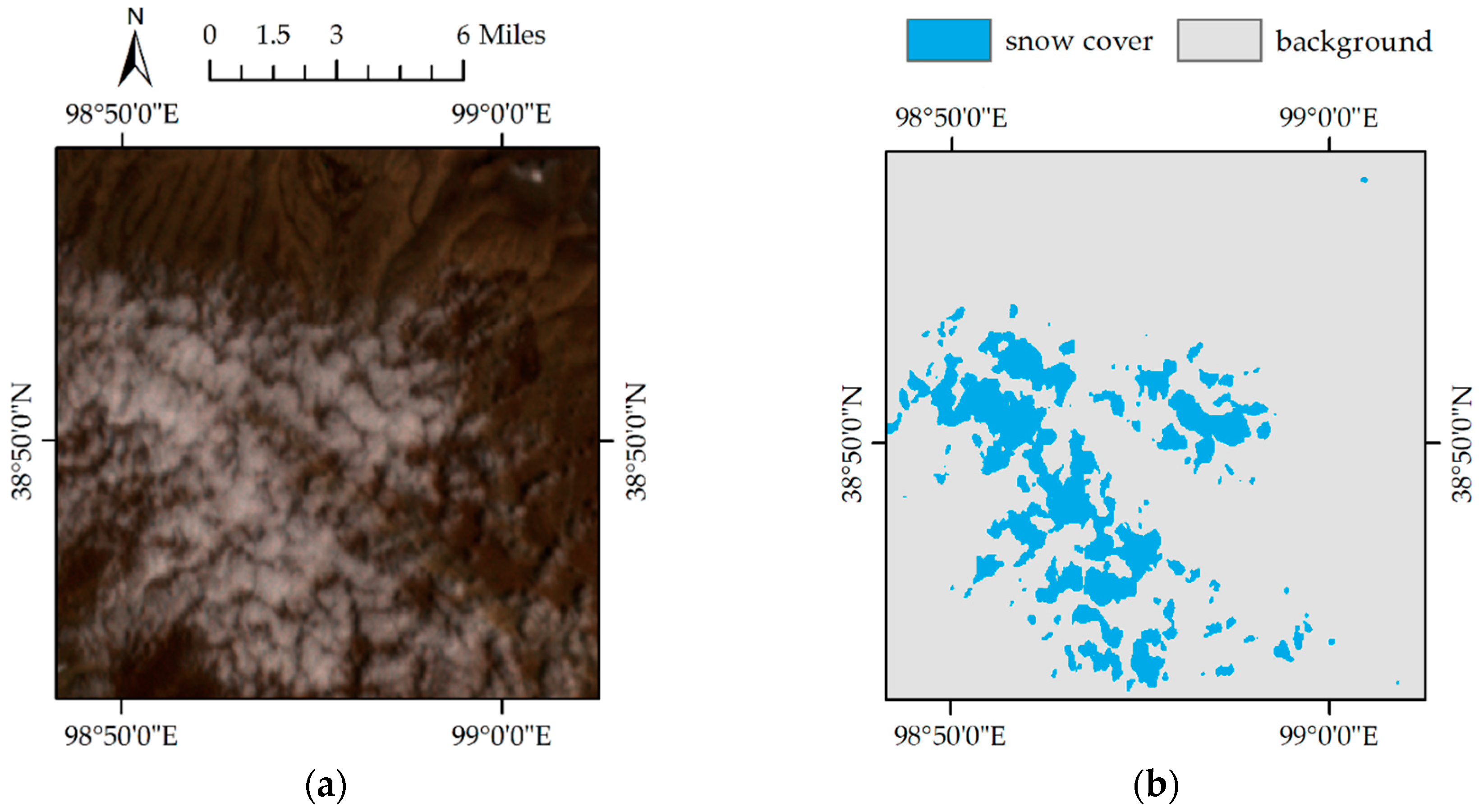
| Sensor Parameters | GF-4 PMS | Landsat-8 OLI | |
|---|---|---|---|
| Wavelength Range/μm | Blue Band | 0.44–0.53 | 0.45–0.51 |
| Green Band | 0.51–0.61 | 0.53–0.59 | |
| Red Band | 0.61–0.70 | 0.64–0.67 | |
| NIR Band | 0.74–0.91 | 0.85–0.88 | |
| Central Wavelength/μm | Blue Band | 0.5190 | 0.4826 |
| Green Band | 0.5500 | 0.5613 | |
| Red Band | 0.6280 | 0.6546 | |
| NIR 1 Band | 0.7700 | 0.8646 | |
| Spatial Resolution/m | 50 | 30 | |
| Path/Row | Intercept | Coefficient | |||
|---|---|---|---|---|---|
| Blue Band | Green Band | Red Band | NIR Band | ||
| 113/21 | 0.058 | −0.160 | −0.176 | 0.166 | 0.213 |
| 123/26 | 0.094 | −0.360 | −0.163 | 0.607 | −0.106 |
| 124/32 | 0.051 | −0.458 | 0.143 | −0.062 | 0.396 |
| 131/40 | 0.051 | −0.637 | 0.152 | 0.118 | 0.390 |
| 134/40 | 0.030 | −0.227 | −0.005 | −0.103 | 0.405 |
| 136/40 | 0.058 | −0.687 | 0.057 | 0.153 | 0.507 |
| 136/41 | 0.050 | −0.591 | 0.080 | 0.161 | 0.394 |
| 150/33 | 0.034 | −0.309 | 0.044 | −0.317 | 0.652 |
| 151/33 | 0.043 | −0.114 | 0.153 | −0.466 | 0.473 |
| Standard deviation | 0.018 | 0.211 | 0.126 | 0.313 | 0.213 |
| Cluster | Intercept | Coefficient | Cluster Center | ||
|---|---|---|---|---|---|
| Red Band | NIR Band | R&S 1 | N&S 2 | ||
| 1 | 0.004 | −0.169 | 0.253 | 0.884 | 0.870 |
| 2 | 0.018 | 0.137 | 0.102 | 0.539 | 0.550 |
| 3 | 0.010 | −0.048 | 0.181 | 0.740 | 0.732 |
| Test Site | Sensor | Acquisition Date | Acquisition Time | Solar Zenith | Solar Azimuth |
|---|---|---|---|---|---|
| No. 1 | GF-4 PMS | 18 December 2016 | 10:56 | 66.38° | 160.07° |
| Landsat-8 OLI | 14 December 2016 | 10:53 | 67.12° | 161.90° | |
| No. 2 | GF-4 PMS | 16 October 2016 | 11:02 | 57.54° | 140.17° |
| Landsat-8 OLI | 15 October 2016 | 11:08 | 50.01° | 158.35° |
| Category | Producer Accuracy | User Accuracy | Commission 1 | Omission 2 | Overall Accuracy |
|---|---|---|---|---|---|
| Snow Cover | 95.00% | 99.38% | 0.62% | 5.00% | 97.99% |
| Background | 98.63% | 97.71% | 2.29% | 1.47% |
| Test Site | Blue Band | Green Band | Red Band | NIR Band |
|---|---|---|---|---|
| No. 1 | 69 | 0 | 140 | 1027 |
| No. 2 | 478 | 0 | 1068 | 10 |
© 2018 by the authors. Licensee MDPI, Basel, Switzerland. This article is an open access article distributed under the terms and conditions of the Creative Commons Attribution (CC BY) license (http://creativecommons.org/licenses/by/4.0/).
Share and Cite
Zhang, T.; Ren, H.; Qin, Q.; Sun, Y. Snow Cover Monitoring with Chinese Gaofen-4 PMS Imagery and the Restored Snow Index (RSI) Method: Case Studies. Remote Sens. 2018, 10, 1871. https://doi.org/10.3390/rs10121871
Zhang T, Ren H, Qin Q, Sun Y. Snow Cover Monitoring with Chinese Gaofen-4 PMS Imagery and the Restored Snow Index (RSI) Method: Case Studies. Remote Sensing. 2018; 10(12):1871. https://doi.org/10.3390/rs10121871
Chicago/Turabian StyleZhang, Tianyuan, Huazhong Ren, Qiming Qin, and Yuanheng Sun. 2018. "Snow Cover Monitoring with Chinese Gaofen-4 PMS Imagery and the Restored Snow Index (RSI) Method: Case Studies" Remote Sensing 10, no. 12: 1871. https://doi.org/10.3390/rs10121871
APA StyleZhang, T., Ren, H., Qin, Q., & Sun, Y. (2018). Snow Cover Monitoring with Chinese Gaofen-4 PMS Imagery and the Restored Snow Index (RSI) Method: Case Studies. Remote Sensing, 10(12), 1871. https://doi.org/10.3390/rs10121871








